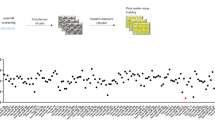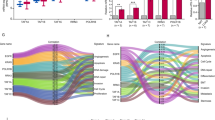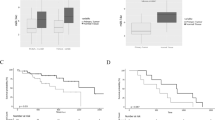Abstract
MicroRNAs (miRNAs) have recently emerged as an important new class of cellular regulators that control various cellular processes and are implicated in human diseases, including cancer. Here, we show that loss of let-7 function enhances lung tumor formation in vivo, strongly supporting the hypothesis that let-7 is a tumor suppressor. Moreover, we report that exogenous delivery of let-7 to established tumors in mouse models of non-small-cell lung cancer (NSCLC) significantly reduces the tumor burden. These results demonstrate the therapeutic potential of let-7 in NSCLC and point to miRNA replacement therapy as a promising approach in cancer treatment.
This is a preview of subscription content, access via your institution
Access options
Subscribe to this journal
Receive 50 print issues and online access
$259.00 per year
only $5.18 per issue
Buy this article
- Purchase on Springer Link
- Instant access to full article PDF
Prices may be subject to local taxes which are calculated during checkout




Similar content being viewed by others
References
Bitko V, Barik S . (2008). Nasal delivery of siRNA. Methods Mol Biol 442: 75–82.
Bitko V, Musiyenko A, Shulyayeva O, Barik S . (2005). Inhibition of respiratory viruses by nasally administered siRNA. Nat Med 11: 50–55.
Brown JM, Wilson G . (2003). Apoptosis genes and resistance to cancer therapy: what does the experimental and clinical data tell us? Cancer Biol Ther 2: 477–490.
Calin GA, Liu C-G, Sevignani C, Ferracin M, Felli N, Dumitru CD et al. (2004a). MicroRNA profiling reveals distinct signatures in B cell chronic lymphocytic leukemias. Proc Natl Acad Sci USA 101: 11755–11760.
Calin GA, Sevignani C, Dumitru CD, Hyslop T, Noch E, Yendamuri S et al. (2004b). Human microRNA genes are frequently located at fragile sites and genomic regions involved in cancers. Proc Natl Acad Sci USA 101: 2999–3004.
Edinger AL, Thompson CB . (2004). Death by design: apoptosis, necrosis and autophagy. Curr Opin Cell Biol 16: 663–669.
Esquela-Kerscher A, Johnson SM, Bai L, Saito K, Partridge J, Reinert KL et al. (2005). Post-embryonic expression of C elegans microRNAs belonging to the lin-4 and let-7 families in the hypodermis and the reproductive system. Dev Dyn 234: 868–877.
Esquela-Kerscher A, Slack FJ . (2006). Oncomirs—microRNAs with a role in cancer. Nat Rev Cancer 6: 259–269.
Esquela-Kerscher A, Trang P, Wiggins JF, Patrawala L, Cheng A, Ford L et al. (2008). The let-7 microRNA reduces tumor growth in mouse models of lung cancer. Cell Cycle 7: 759–764.
Hohla F, Schally AV, Kanashiro CA, Buchholz S, Baker B, Kannadka C et al. (2007). Growth inhibition of non-small-cell lung carcinoma by BN/GRP antagonist is linked with suppression of K-Ras, COX-2, and pAkt. Proc Natl Acad Sci USA 104: 18671–18676.
Isobe T, Herbst RS, Onn A . (2005). Current management of advanced non-small cell lung cancer: targeted therapy. Semin Oncol 32: 315–328.
Jackson EL, Olive KP, Tuveson DA, Bronson R, Crowley D, Brown M et al. (2005). The differential effects of mutant p53 alleles on advanced murine lung cancer. Cancer Res 65: 10280–10288.
Jackson EL, Willis N, Mercer K, Bronson RT, Crowley D, Montoya R et al. (2001). Analysis of lung tumor initiation and progression using conditional expression of oncogenic K-ras. Genes Dev 15: 3243–3248.
Johnson CD, Esquela-Kerscher A, Stefani G, Byrom M, Kelnar K, Ovcharenko D et al. (2007). The let-7 microRNA represses cell proliferation pathways in human cells. Cancer Res 67: 7713–7722.
Johnson SM, Grosshans H, Shingara J, Byrom M, Jarvis R, Cheng A et al. (2005). RAS is regulated by the let-7 microRNA family. Cell 120: 635–647.
Kota J, Chivukula RR, O'Donnell KA, Wentzel EA, Montgomery CL, Hwang HW et al. (2009). Therapeutic microRNA delivery suppresses tumorigenesis in a murine liver cancer model. Cell 137: 1005–1017.
Krutzfeldt J, Rajewsky N, Braich R, Rajeev KG, Tuschl T, Manoharan M et al. (2005). Silencing of microRNAs in vivo with ‘antagomirs’. Nature 438: 685–689.
Kumar MS, Erkeland SJ, Pester RE, Chen CY, Ebert MS, Sharp PA et al. (2008). Suppression of non-small cell lung tumor development by the let-7 microRNA family. Proc Natl Acad Sci USA 105: 3903–3908.
Lee YS, Dutta A . (2007). The tumor suppressor microRNA let-7 represses the HMGA2 oncogene. Genes Dev 21: 1025–1030.
Levenkova N, Gu Q, Rux JJ . (2004). Gene specific siRNA selector. Bioinformatics 20: 430–432.
Mayr C, Hemann MT, Bartel DP . (2007). Disrupting the pairing between let-7 and Hmga2 enhances oncogenic transformation. Science 315: 1576–1579.
Nikitin AY, Alcaraz A, Anver MR, Bronson RT, Cardiff RD, Dixon D et al. (2004). Classification of proliferative pulmonary lesions of the mouse: recommendations of the mouse models of human cancers consortium. Cancer Res 64: 2307–2316.
Park SM, Shell S, Radjabi AR, Schickel R, Feig C, Boyerinas B et al. (2007). Let-7 prevents early cancer progression by suppressing expression of the embryonic gene HMGA2. Cell Cycle 6: 2585–2590.
Roush S, Slack FJ . (2008). The let-7 family of microRNAs. Trends Cell Biol 18: 505–516.
Sampson VB, Rong NH, Han J, Yang Q, Aris V, Soteropoulos P et al. (2007). MicroRNA let-7a downregulates MYC and reverts MYC-induced growth in Burkitt lymphoma cells. Cancer Res 67: 9762–9770.
Sevignani C, Calin GA, Nnadi SC, Shimizu M, Davuluri RV, Hyslop T et al. (2007). MicroRNA genes are frequently located near mouse cancer susceptibility loci. Proc Natl Acad Sci USA 104: 8017–8022.
Siegfried JM, Krishnamachary N, Gaither Davis A, Gubish C, Hunt JD, Shriver SP . (1999). Evidence for autocrine actions of neuromedin B and gastrin-releasing peptide in non-small cell lung cancer. Pulm Pharmacol Ther 12: 291–302.
Soucek L, Whitfield J, Martins CP, Finch AJ, Murphy DJ, Sodir NM et al. (2008). Modelling Myc inhibition as a cancer therapy. Nature 455: 679–683.
Takamizawa J, Konishi H, Yanagisawa K, Tomida S, Osada H, Endoh H et al. (2004). Reduced expression of the let-7 microRNAs in human lung cancers in association with shortened postoperative survival. Cancer Res 64: 3753–3756.
Takeshita F, Patrawala L, Osaki M, Takahashi RU, Yamamoto Y, Kosaka N et al. (2009). Systemic delivery of synthetic microRNA-16 inhibits the growth of metastatic prostate tumors via downregulation of multiple cell-cycle genes. Mol Ther (e-pub ahead of print 8 September 2009).
Yanaihara N, Caplen N, Bowman E, Seike M, Kumamoto K, Yi M et al. (2006). Unique microRNA molecular profiles in lung cancer diagnosis and prognosis. Cancer Cell 9: 189–198.
Yu F, Yao H, Zhu P, Zhang X, Pan Q, Gong C et al. (2007). let-7 regulates self renewal and tumorigenicity of breast cancer cells. Cell 131: 1109–1123.
Acknowledgements
We acknowledge Xianping Liang for help with animal husbandry and genotyping, and Paul Lebourgeois for histopathological analyses. PT was supported by an NIH NRSA postdoctoral fellowship (F32CA130376). PM was supported by a postdoctoral fellowship from the Ministry of Education and Science of Spain (MEC) and from the Hope Funds for Cancer Research. JBW was supported by the ASTRO Junior Faculty Career Research Training Award. FJS and JBW were supported by grants from the NIH (CA131301-01A1) and from the Connecticut Department of Public Health (RFP no. 2006-0913).
Author information
Authors and Affiliations
Corresponding authors
Additional information
Supplementary Information accompanies the paper on the Oncogene website (http://www.nature.com/onc)
Supplementary information
Rights and permissions
About this article
Cite this article
Trang, P., Medina, P., Wiggins, J. et al. Regression of murine lung tumors by the let-7 microRNA. Oncogene 29, 1580–1587 (2010). https://doi.org/10.1038/onc.2009.445
Received:
Revised:
Accepted:
Published:
Issue Date:
DOI: https://doi.org/10.1038/onc.2009.445
Keywords
This article is cited by
-
Recent trends in miRNA therapeutics and the application of plant miRNA for prevention and treatment of human diseases
Future Journal of Pharmaceutical Sciences (2022)
-
Can microRNA become next-generation tools in molecular diagnostics and therapeutics? A systematic review
Egyptian Journal of Medical Human Genetics (2021)
-
The role of noncoding RNAs in epithelial cancer
Cell Death Discovery (2020)
-
LncRNA CDKN2B-AS1/miR-141/cyclin D network regulates tumor progression and metastasis of renal cell carcinoma
Cell Death & Disease (2020)
-
Inhibition of RNA-binding proteins with small molecules
Nature Reviews Chemistry (2020)



